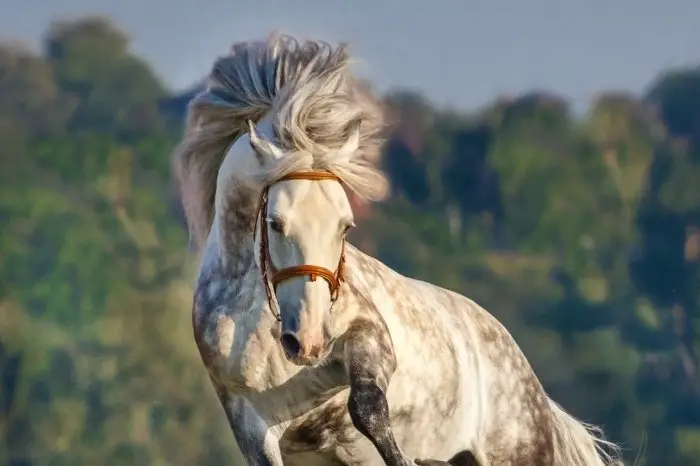Last Updated on February 4, 2022
A long flowing mane on a horse truly is a beautiful sight! But do all horses have manes? And what is the purpose of this unusual hair? Keep reading and let’s find out!
What Is The Mane On A Horse?
The mane of a horse is the ridge of hair that grows along the top of the neck. The hair type of the mane is very different from that of the body. On the body of a horse, we will find soft, short hair, whereas the mane hair is longer, thicker, and wirier, similar to the hair of the tail.
A horse’s mane also includes the section of hair in between the ears, that falls over the forehead of the horse. This is called the forelock.
The mane of a horse varies widely according to the breed and type of the horse. Hot-blooded and warm-blooded breeds tend to have finer manes with thinner hairs. These can be prone to breakage, but if cared for correctly the result can be a beautiful, long, and flowing mane.

Cold-blooded breeds tend to have manes that are much thicker, with dense, wiry hair. Good examples of these include the British native ponies, such as the Shetland pony, and North European draft horses like the Belgian Draught.
When it comes to the color of a horse’s mane, there are some interesting genetic influences happening here! The color that determines the body color of a horse is not always the same as the one which creates the color of the mane and tail. This is why we end up with spectacular two-tone horses such as palomino and flaxen chestnuts.
Click Here to Learn More About:
Do All Horses Have Manes?
All horses do have manes, and it is just the length and thickness of the mane that differs. Every type of equine has a mane – horses, ponies, zebras, donkeys, mules, and hinnies.
Of all these types of equine, it is normally just horses and ponies that have long manes which fall over the side of the neck. All of the others tend to resemble the ancient wild horses, with a short, upright mane.
Horse Grooming Kit(10-Piece) with Tote, Horse Cleaning Tool Set
If you see a horse with no mane, it is unlikely that it is naturally this way. It is commonplace for horses to have their manes clipped off, leaving the crest of the neck smooth and hair-free. This procedure is called ‘roaching’ or ‘hogging’ and is common practice in horse types such as show cobs.
Some horses also rub their manes, leaving the crest bald. This is a sign of intense itching, caused by a parasite or skin infection. A common cause is a sweet itch, an allergic reaction to midge, and mosquito bites.
Read more about Shetland Pony Lifespan Facts And Figures Revealed!
Summary – Do All Horses Have Manes?
So, as we have learned, all horses have manes but the length and thickness of the hair vary widely between the breed of horse. Some equines, such as donkeys and zebras, have short manes that stand upright. Other breeds of horses, like the beautiful Friesian, have long, flowing manes that can grow right down to the floor!
We would love to hear your thoughts on whether all horses have manes! Do you know a horse that has a particularly beautiful mane? Or maybe your horse has a tangled, messy mane that is a nightmare to manage? Leave a comment below and we’ll get back to you!
FAQ’s

Kate Chalmers is a qualified veterinary nurse who has specialized in horse care for the vast majority of her career. She has been around horses since she was a child, starting out riding ponies and helping out at the local stables before going on to college to study Horse Care & Management. She has backed and trained many horses during her lifetime and competed in various equestrian sports at different levels.
After Kate qualified as a veterinary nurse, she provided nursing care to the patients of a large equine veterinary hospital for many years. She then went on to teach horse care and veterinary nursing at one of the top colleges in the country. This has led to an in-depth knowledge of the care needs of horses and their various medical ailments, as well as a life-long passion for educating horse owners on how to provide the best possible care for their four-legged friends.
Kate Chalmers BSc (Hons) CVN, Dip AVN (Equine) Dip HE CVN EVN VN A1 PGCE

